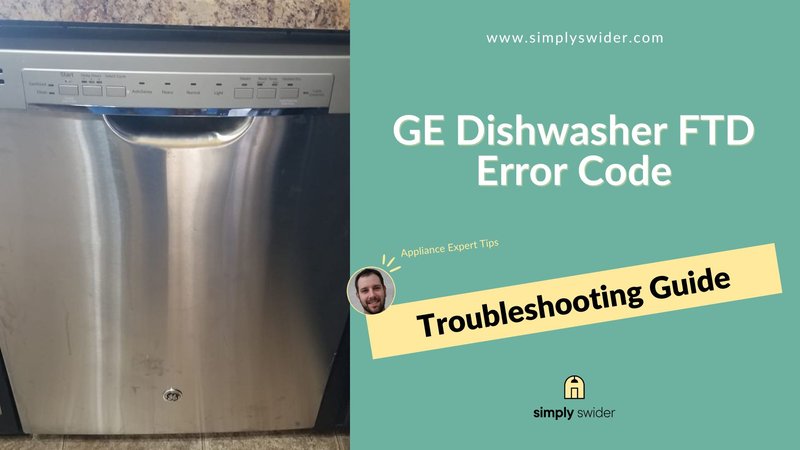
Now, you might be thinking, “Leakage? But I don’t see any water on the floor!” Well, the LE code could mean an internal or less obvious leak somewhere inside the machine, where water sensors detect excess moisture or water escape. It’s like having an invisible spill that stays hidden, but the dishwasher knows something’s wrong. So, let’s explore what’s really going on and how you can tackle it without needing a PhD in dishwashing technology.
Understanding the GE Dishwasher Error Code LE
When your GE dishwasher flashes an LE error code, it’s signaling a leakage issue. This doesn’t always mean water is flooding your kitchen floor, but rather, it could be a small, contained leak or an internal sensor picking up excess moisture. Imagine having a tiny hole in a water bottle; the leak isn’t always visible externally, but the water level inside tells a different story. The dishwasher is smart enough to sense these internal discrepancies, alerting you via the LE code.
The role of this error code is quite essential. It functions like a smoke alarm for water issues in your appliance. Without such alerts, you might continue using the dishwasher until the problem becomes catastrophic — like, say, flooding your kitchen. By warning you early, the error code prevents potential water damage not only to your dishwasher but to your cabinetry and flooring too. It saves you from the bigger hassle of extensive repairs.
Here’s the good news: Just because your dishwasher throws an LE code doesn’t mean it’s on its last leg. It’s more of a helpful nudge to address a potential problem before it escalates. So, let’s tackle some common causes and what you can do about them.
Common Causes of the LE Error Code in GE Dishwashers
1. Faulty Door Gasket: The door gasket is like the seal on a refrigerator, ensuring everything stays inside. If it’s cracked or out of place, water can escape, triggering the LE code. Imagine if your fridge door couldn’t close tightly — you’d end up with spoiled food. In the dishwasher’s case, a bad seal lets water seep where it shouldn’t. Checking the gasket for wear or misalignment and replacing it if necessary can often resolve the issue.
2. Clogged or Faulty Drain Hose: A blocked or damaged drain hose can cause water to linger in the machine longer than it should, creating internal leaks. It’s like a clogged sink; everything backs up instead of flowing away smoothly. Investigate the hose for any kinks, clogs, or damage. Cleaning or replacing it can restore proper water flow and stop the error code.
3. Malfunctioning Water Inlet Valve: This valve controls the water entering your dishwasher. If it’s faulty, too much water can flood in, much like a faucet that’s stuck on. Testing the valve for proper function is crucial. If it doesn’t open and close as it should, replacing it could solve your LE troubles.
Steps to Troubleshoot and Resolve the LE Error Code
If you’ve got an LE error code, here’s the deal — you can often fix it without calling a professional. Start by inspecting the door gasket. Open the dishwasher door and run your fingers along the rubber seal. Feel for any tears or areas where it might not be compressing properly when the door is closed. If it’s damaged, replacing it is usually straightforward; just consult your user manual for the right part.
Next, turn your attention to the drain hose. This is typically found at the back of the dishwasher. Make sure it’s not bent or obstructed. Disconnect it to check if water flows through unimpeded. If it feels clogged, a gentle rinse or using a long, flexible brush can help clear any blockages. Remember to ensure it’s securely reattached when you’re finished.
If these steps don’t resolve the problem, the water inlet valve might be the culprit. You’ll need to access the bottom panel of your dishwasher — most models allow easy removal for maintenance. Testing this valve often requires a multimeter to check for continuity. If you’re not comfortable with this, consulting a professional might be wise. But if you’re game, replacing a faulty valve could be a cost-effective fix.
Preventative Measures to Avoid Future LE Error Codes
Prevention, as they say, is better than cure. Regular cleaning and maintenance of your dishwasher can help avoid these pesky error codes. For starters, inspect the door gasket every few months and wipe it clean of any food particles or buildup. It’s like brushing your teeth regularly to prevent cavities. When the seals are clean and pliant, they do a better job of keeping water where it belongs.
Routinely flush your drain hose of any debris. It’s simple — once every six months, remove the hose and check for the unimpeded flow of water. If you use your dishwasher daily, consider shorter inspection cycles. It’s akin to changing the oil in your car: regular checks keep everything running smoothly.
Finally, ensure the water inlet valve isn’t leaking or showing signs of wear. Just like checking your home’s faucets for drips, keeping an eye on the valve can prevent overflows and water damage. By spending a little time on maintenance, you can save a lot of time and frustration down the road.
In conclusion, while the GE dishwasher LE error code can be a bit of a head-scratcher, tackling its common causes with some straightforward troubleshooting can often save the day. By understanding what triggers this code and addressing it promptly, you’re not only protecting your appliance but also avoiding larger water damage concerns in your kitchen. Keep these tips in mind, and you’ll be well on your way to smooth sailing—or should we say, smooth washing?